BIOCH 200: Slide 9 Glycolysis + Pyruvate Dehydrogenase (PDH)
1/131
There's no tags or description
Looks like no tags are added yet.
Name | Mastery | Learn | Test | Matching | Spaced |
|---|
No study sessions yet.
132 Terms
Is glycolysis catabolic or anabolic?
Catabolic
What is the overall purpose of Glycolysis?
1 Glucose —> 2 Pyruvate
Does substrate level Phosphorylation occur in glycolysis?
Yes
Generates ATP directly
How does Glycolysis generate NADH?
From the OXIDATION of metabolites (catabolic)
Where does Glycolysis Occur?
Cytoplasm of the cell
Outside of the mitochondria
Gluconeogenesis? Glycogenolysis? Glycogen synthesis?

At which step of glycolysis does Glycogen synthesis/glycogenolysis tie in?
G6P Enters Glycolysis
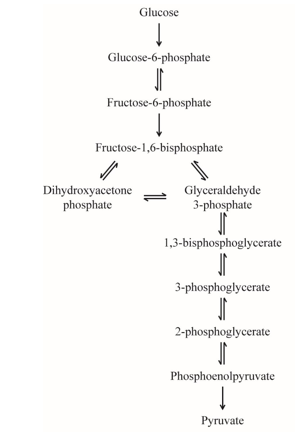
What are the 2 stages of Glycolysis?
Energy investment
ATP = used
Energy payout
ATP = made
NADH = made
Which steps of glycolysis = energy investment and which are payout
All steps with HEXOSE (6 C) = Invest
All steps with TRIOSE (3C) = Pay out
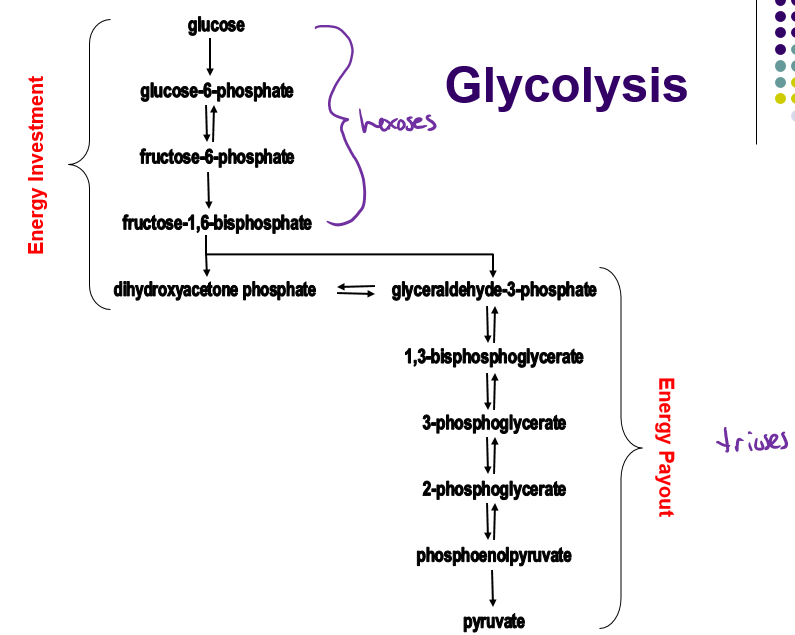
What are the 4 enzymes to know for glycolysis?
Associated with:
2/2 rxns that use ATP
2/3 E capture steps (6=NADH + 10 = ATP)

Which 3 enzymes of Glycolysis are regulated?
Hexokinase
Phosphofructokinase-1 (PFK-1)
Pyruvate kinase
What is a commonality of the rxns that have regulated enzymes?
They are IRREVERSIBLE
In which Rxns is ATP used?
STEP 1: Glucose —> G6P (enzyme: Hexokinase
STEP 3: F6P —> Fructose-1,6-BP (Enzyme: PFK-1)
What is the commonality between the 2 steps that require ATP investment as E?
They are IRREVERSIBLE + catalyzed by regulated enzymes
What is the Net RXN of the E investment Phase?
Glucose + 2 ATP —> 2 GAP + 2 ADP + 2H+
What kind of rxn is step 1: Glucose —> G6P?
Phosphate transfer
Hexokinase = phosphorylate
What kind of rxn is STEP 2: G6P —> F6P
Isomerization
Glucose + fructose are isomers
What kind of rxn is STEP 3: F6P —> F-1,6-BP?
Phosphate transfer rxn
Phosphofructokinase-1 = Phosphorylation

A. - 46 KJ/mol
B. - 22 KJ/mol
C. - 18 KJ/mol
D. 18 KJ/mol
E. 46 KJ/mol
C. Net = -32 + 14 = -18
What kind of rxn is STEP 4: F-1,6-BP —> DHAP + GAP?
LYSIS of glycolysis
What is the relationship between DHAP + GAP?
They are ISOMERS
Why is there 2 pyruvates per 1 Glucose?
DHAP + GAP = Isomers
DHAP = converted to GAP = 2 GAP
Every rxn from GAP —> Pyruvate = occurs twice
What is the net rxn of the E payout steps?
2x: GAP + NAD+ + Pi + 2ADP —> Pyruvate + NADH + 2 ATP + H2O + H+
What kind of rxn is STEP 6: GAP/G3P —> 1,3- BPGlycerate?
The OXIDATION part of glycolysis
PHOSPHATE ADDITION (Pi)
E capture step (NADH)
What type of Rxn is STEP 7: 1,3-BPG —> 3-PG
Substrate Lvl Phosphorylation (aka. Phosphate-transfer)
E capture step (ATP captured directly as result of substrate lvl phosphorylation)
1,3-BPG = has large phosphate transfer potential
Why does 1,3-BPG have a large phosphate transfer potential
It has an Acyl Phosphate
the product it forms is resonance stabilized
True or False: ALL substrate lvl phosphorylation steps = E capture steps?
True
but not all E capture steps = substrate lvl phosphorylation
What kind of Rxn is STEP 8: 3-PG —> 2-PG
ISOMERIZATION
What kind of Rxn is STEP 9: 2PG —> Phosphoenolpyruvate (PEP)?
DEHYDRATION
Double bond = generated
What kind of rxn is STEP 10 (last step): PEP —> Pyruvate?
Substrate Lvl Phosphorylation (Phosphate- transfer)
E capture step (ATP directly from substrate lvl phosphorylation)
True or False: Normally the Rxn from PEP —> Pyruvate is Reversible but in physiological conditions the reverse rxn is NOT favored?
TRUE
What is Enol pyruvate?
High E molecule
Tautomerizes into Pyruvate

What is the result of the tautomerization of Enol Pyruvate?
Large amount of E = released = MAKES the STEP /rxn IRREVERSIBLE
What is the Overall Balanced Rxn of Glycolysis?
Glucose + 2ADP + 2NAD+ + 2Pi —> 2 Pyruvate + 2 ATP + 2 NADH + 2H+ + 2 H2O
What is the NET ATP yield?
2 ATP
2 ATP invested + 4 ATP out
4-2 = 2
Which steps are the E capture steps of Glycolysis?
6, 7 + 10
7 + 10 = ATP
6 = NADH

Which steps are substrate lvl phosphorylation steps
7 + 10 (generated ATP directly)
Which steps are Phosphate transfer steps?
1, 3, 7 + 10
All steps where ATP was involved
ATP investment
Substrate lvl phosphorylation and/or rxns with kinase enzymes
What are the High E molecules involved in Glycolysis
Products: ATP + NADH
Intermediates: Phosphoenolpyruvate (PEP) + 1,3 BPG
Honorable mention Enolpyruvate + G6P
What are the coupled rxns in Glycolysis
Where ATP = involved
Invest: 1 + 3
Payout: 7 +10
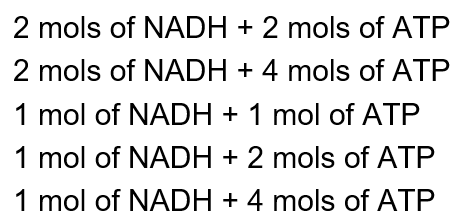
What is the net gain when 1 mol of Dihydroxyacetone phosphate (DHAP) is converted to pyruvate?
D. Only go through second phase of glycolysis once
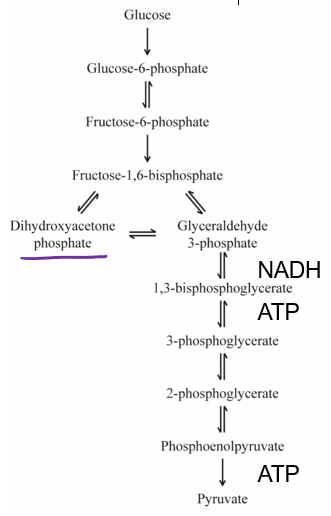
Which steps have a Delta G close to 0 and which have a very negative Delta G?
Close to 0 = REVERSIBLE STEPS
Very negative = IRREVERSIBLE STEPS
What are the Isomerization steps of Glycolysis?
2, 5 + 8

What is the Rate limiting step/ sets pace of Glycolysis?
Step 3: F6P —> F-1,6-BP
Why isn’t step 1 the rate limiting step despite being regulated?
G6P goes into Glycogen synthesis thus the regulation doesn’t control glycolysis exclusively
Step 3 on the other hand is exclusive to glycolysis
Which step is the oxidation step of glycolysis?
First step of Phase 2
G3P/GAP —> 1,3-BPG
NADH = FORMED
Why is Phosphoenolpyruvate a high E intermediate
Enol = unstable, the conversion of PEP —> Pyruvate = highly favorable
phosphate group also = strained position
What are the 3 regulated steps of Glycolysis + which enzymes regulate them
3 Irreversible steps (1, 3 + 10)
STEP 1: Hexokinase
STEP 3: PFK-1
STEP 10: Pyruvate Kinase
What is the balanced equation for STEP 1?

What is the balanced equation for STEP 3?

What is the balanced equation for STEP 10?

Why is glycolysis regulated (3 reasons)
Ensure E needs are met
Not wasting Glucose when ATP = Abundant
Intermediates may be used in other processes
What 4 major processes regulate the Rate of Flux through metabolic pathways?
Substrate availability
Alteration of enzyme activity
Alteration of amount of enzyme
Compartmentation
Define compartmentation
Putting things into storage and Controlling movement of the stored things
What are the 2 types of regulation in glycolysis?
Substrate availability
Glucose import (transporters)
Enzyme regulation (Hexokinase, PFK-1 (rate limiting), Pyruvate Kinase)

Which of the following glycolytic enzymes do expect to not be regulated
D.
What type of Regulation is Hexokinase under?
Product inhibition
G6P = inhibitor
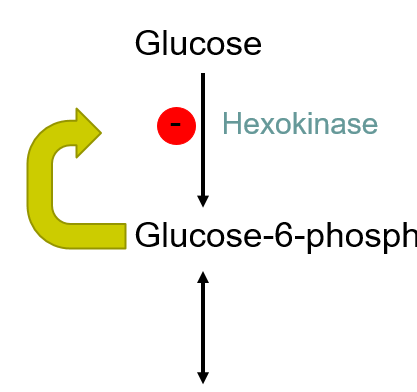
What is G6P to Hexokinase?
Negative allosteric effector
How is PFK-1 Regulated
Allosterically by:
PEP
ADP/AMP
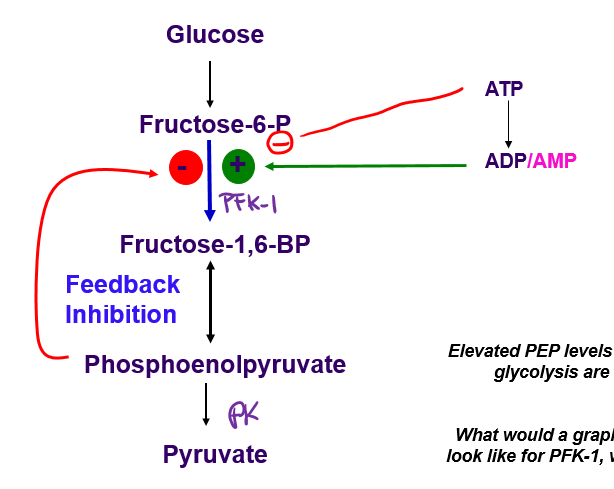
What is PEP (Phosphoenolpyruvates) relation to PFK-1?
Hetero-allosteric Inhibitor/ negative effector/ feed back inhibitor
What do Elevated lvls of PEP indicate
That the products of Glycolysis (Pyruvate) are not being consumed
What is AMP/ADPs relation to PFK-1 allosterically?
Heteroallosteric ACTIVATOR/ Positive effector
Other Allosteric effectors of PEP?
Fructose-2.6-BP (under insulin + glucagon control) respond to blood glucose
Fructose 6 Phosphate = Homoallosteric activator
ATP = HOMOALLOSTERIC inhibitor
Why is the [AMP/ADP] a good indicator of the need of ATP. Why not [ATP] itself?
[ATP] = relatively stable
[AMP/ADP] = increases a lot when ATP = used
What would a graph of activity vs [F6P] look like for PFK-1 with or without PEP and AMP?

What does the sigmoidal curve of Activity of PFK-1 vs. [F6P] graph mean?
Sigmoidal means F6P = Homoallosteric activator
What type of Regulation is Pyruvate kinase under?
Allosteric Regulation
ATP
F-1,6-BP
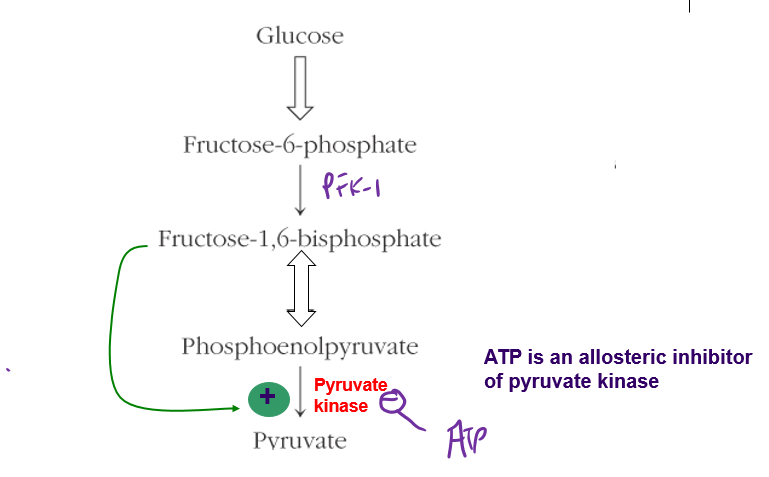
What is the Relationship between ATP and Pyruvate kinase(PK)?
Product inhibition (kind of, other steps also make ATP)
ALLOSTERIC Inhibitor
What is the relationship between F-1,6-BP and PK?
F-1,6-BP = ACTIVATE
FEED forward activation
Heteroallosteric Activator/ positive effector
Which Enzymes Have feedback inhibition/ feed-forward activation/ product inhibition.
Feed back inhibition = PEP on PFK-1
Feed forward activation = F-1,6-BP on PK
Product Inhibition = ATP on PK (Kinda) + G6P on Hexokinase
Gross yield vs. Net yield
Gross = only profit
Net = Profit - Investments
What would a graph of activity vs [PEP] look like for PK with or without F1,6BP and ATP?
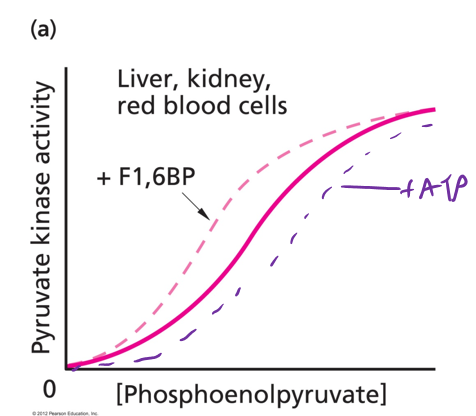
True or False: PEP = Homoallosteric Positive effector of PK?
TRUE
Curve = sigmoidal for graph of PK activity vs [PEP]
Which of the 3 regulated Enzymes are Inhibited by ATP
PK + PFK-1
What does the Regulation of Pk and PFK-1 both by ATP achieve?
Synchronous regulation of irreversible rxns
Flow In = Flow Out
MAINTAIN STEADY STATE
Overview of Glycolysis regulation
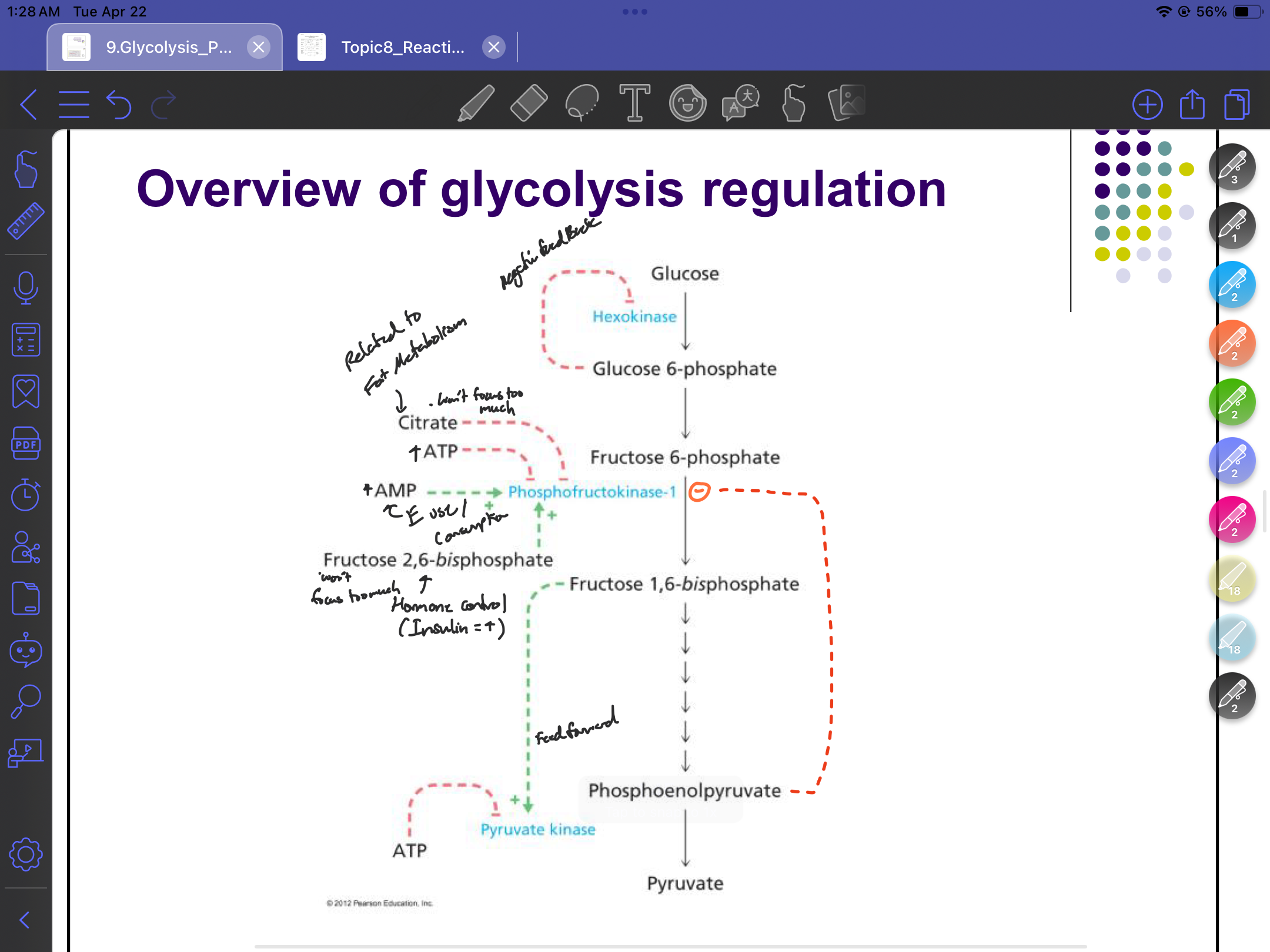
Overview of Glycolysis RXNS
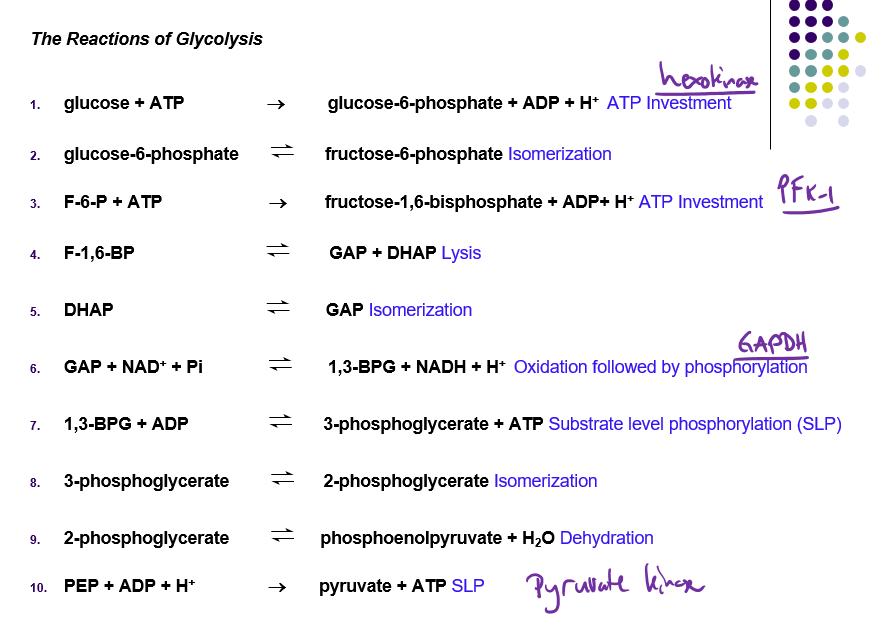
Is glycogen synthesis anabolic or catabolic?
Anabolic
What is glycogen synthesized from?
G6P
Why does Glycogen produce a NET yield of 3 ATP from glycolysis?
No ATP = needed to generate G6P from glycogen
skipping the first step = ATP investment step
Net = 1 ATP invested + 4 ATP obtained
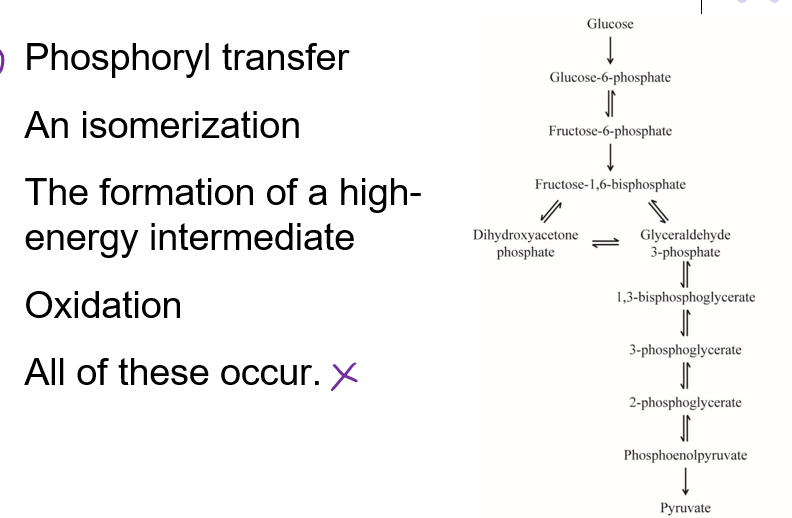
Which of the following does NOT occur in the rxns between F-1,6-BP + 1,3-BPG
A. While 1,3 BPG becomes phosphorylated during the GAPDH reaction, it is through phosphate addition, not transfer.

Which of the following correctly matches the enzyme with its Inhibitor/activator and type of regulation
E.
What are the 3 fates of Pyruvate?
Ethanol
Lactate
Acetyl-CoA (+Oxidative phosphorylation)
Of the 3 fates, which are /is Aerobic and Which are/is Anaerobic
Aerobic = Acetyl CoA
Anaerobic = Lactate + Ethanol
Why is an anaerobic Fate for Pyruvate necessary?
To reoxidize NADH —> NAD+ for the the OXIDATION rxn in glycolysis under anaerobic conditions
What is the purpose of pyruvate metabolism anaerobic?
NADH need to be reoxidized back to NAD+ for Glycolysis to continue
Oxidative phosphorylation (aerobic)
Pyruvate reduction (Anaerobic)
Ethanol + Lactate
What is the equation which describes the fate of pyruvate in anaerobic muscle.

True or False: Lactate is an acid
FALSE: it is not an acid
True or False: Lactate is a dead end product for all parts of the body.
False
Muscle = DEAD END product
Heart =/= Dead end product
Why is lactate considered a dead end product for skeletal Muscle in ANAEROBIC acitivity
We can’t do much with it other than turn it back into Pyruvate
What happens to Lactate in muscle other than staying there?
It gets exported from the muscle in to BLOOD
How is Lactate exported into blood?
Specific membrane transporter proteins
Symporter with H+
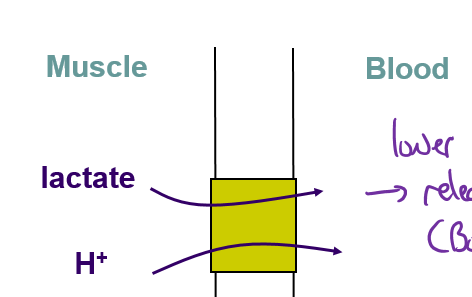
What is the metabolic effect of the export of lactate —> blood? Think Blood, Heart + glycolysis?
H+ is transported out with lactate = lowers the pH of blood = decrease affinity of Hb for O2 = release of O2 (Bohr effect)
Lactate in blood can be transported to heart for use
Prevents the build up of Lactate = prevent build up of pyruvate which would inhibit PK action
What is the ACTUAL source of acid in muscle if Lactic acid is a myth?

Why is lactate not a Dead end product for the Heart?
The heart is ALWAYS under AEROBIC conditions in which lactate can be used as metabolic fuel
How lactate is used as metabolic fuel under aerobic conditions?
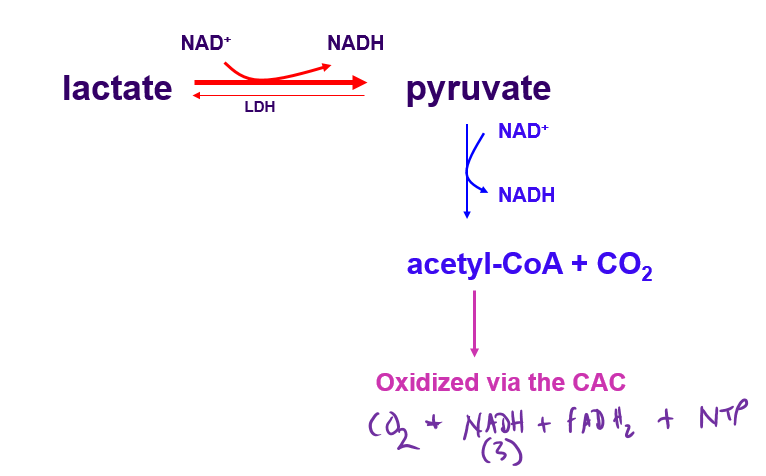
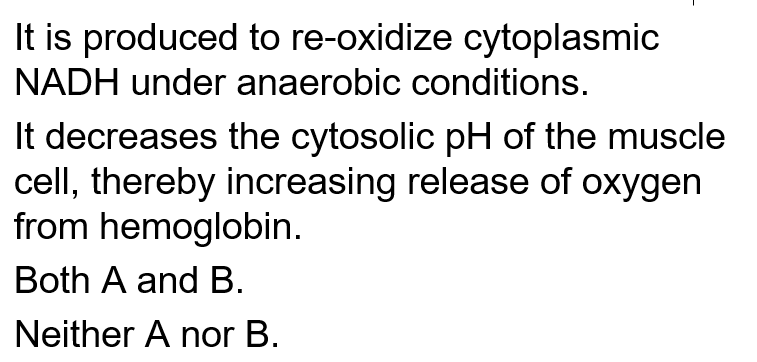
What is the biochemical purpose for the production of lactate in muscle cells
A.
What is the Pyruvate dehydrogenase rxn?
It is the aerobic fate of pyruvate
Pyruvate —> Acetyl CoA
Links glycolysis to CAC
Where does the pyruvate dehydrogenase rxn occur?
Mitochondrial matrix
What catalyzes the Pyruvate Dehydrogenase rxn?
Pyruvate dehydrogenase Complex
PDH, PDC